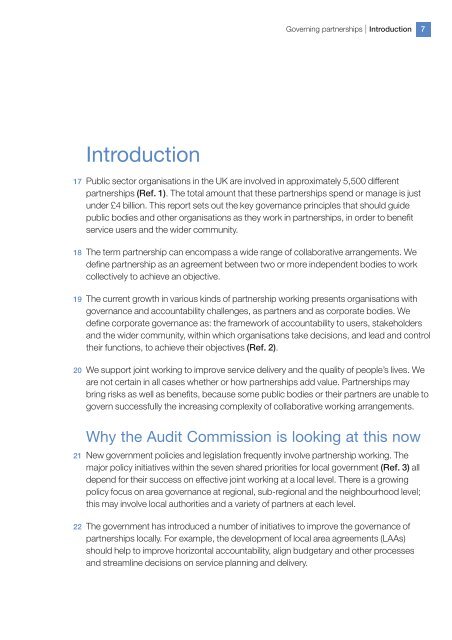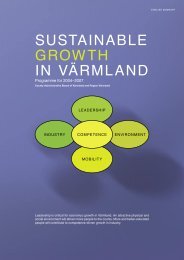Bridging the accountability gap - Audit Commission
Bridging the accountability gap - Audit Commission
Bridging the accountability gap - Audit Commission
Create successful ePaper yourself
Turn your PDF publications into a flip-book with our unique Google optimized e-Paper software.
Governing partnerships | Introduction 7<br />
Introduction<br />
17 Public sector organisations in <strong>the</strong> UK are involved in approximately 5,500 different<br />
partnerships (Ref. 1). The total amount that <strong>the</strong>se partnerships spend or manage is just<br />
under £4 billion. This report sets out <strong>the</strong> key governance principles that should guide<br />
public bodies and o<strong>the</strong>r organisations as <strong>the</strong>y work in partnerships, in order to benefit<br />
service users and <strong>the</strong> wider community.<br />
18 The term partnership can encompass a wide range of collaborative arrangements. We<br />
define partnership as an agreement between two or more independent bodies to work<br />
collectively to achieve an objective.<br />
19 The current growth in various kinds of partnership working presents organisations with<br />
governance and <strong>accountability</strong> challenges, as partners and as corporate bodies. We<br />
define corporate governance as: <strong>the</strong> framework of <strong>accountability</strong> to users, stakeholders<br />
and <strong>the</strong> wider community, within which organisations take decisions, and lead and control<br />
<strong>the</strong>ir functions, to achieve <strong>the</strong>ir objectives (Ref. 2).<br />
20 We support joint working to improve service delivery and <strong>the</strong> quality of people’s lives. We<br />
are not certain in all cases whe<strong>the</strong>r or how partnerships add value. Partnerships may<br />
bring risks as well as benefits, because some public bodies or <strong>the</strong>ir partners are unable to<br />
govern successfully <strong>the</strong> increasing complexity of collaborative working arrangements.<br />
Why <strong>the</strong> <strong>Audit</strong> <strong>Commission</strong> is looking at this now<br />
21 New government policies and legislation frequently involve partnership working. The<br />
major policy initiatives within <strong>the</strong> seven shared priorities for local government (Ref. 3) all<br />
depend for <strong>the</strong>ir success on effective joint working at a local level. There is a growing<br />
policy focus on area governance at regional, sub-regional and <strong>the</strong> neighbourhood level;<br />
this may involve local authorities and a variety of partners at each level.<br />
22 The government has introduced a number of initiatives to improve <strong>the</strong> governance of<br />
partnerships locally. For example, <strong>the</strong> development of local area agreements (LAAs)<br />
should help to improve horizontal <strong>accountability</strong>, align budgetary and o<strong>the</strong>r processes<br />
and streamline decisions on service planning and delivery.








